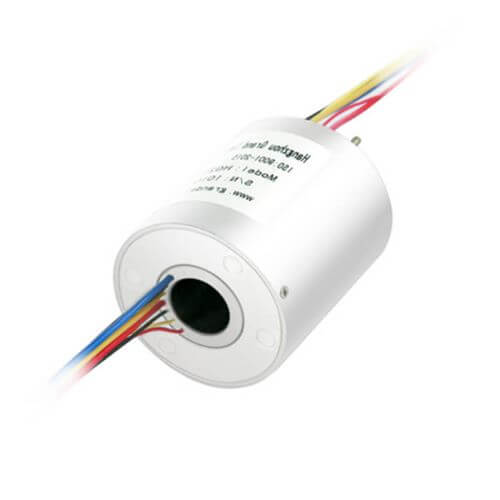Over the past three decades, optical fibers have revolutionized the telecommunications industry. In terms of transmission speed, security, weight, cost, bandwidth, and lifespan have huge advantages over traditional copper cables. An optical fiber rotary joint is a device that allows the transmission of an optical signal through the interface between a continuous rotating platform and its fixed structure. Also called optical rotary connectors or optical slip rings, the applications of optical fiber rotary joints have spread with the increasing acceptance of transmission lines of fiber optic communication.
Optical fiber rotary joints are a means of passing signals through rotating interfaces, especially when transmitting large amounts of data. They retain the key benefits of end-to-end fibers and are available in single as well as multi-channel options. The size and most economical options are single and double-channel designs. If there is more than one fiber in the system, multiplexing solutions are available to combine several channels on one/ two fibers to allow Optical fiber rotary joints to use one/two channels.
Types of Optical Fiber Rotary Joints
There are two types of optical fiber rotary joints; single-mode and multimode. Single-mode fibers allow only a kind of optical energy to propagate due to their small size and small numerical aperture. For this reason, they display very high-frequency bands at wavelengths between 1 270 nm and 1,650 nm. These fibers are designed with exact mechanical alignment. The alignment requirements depend on the wavelength of the optical fiber rotary joints analysis. Multimode fibers have massive cores and large digital apertures that allow multiple models of light energy to propagate. These properties allow more light to be transferred from sources such as VCSEL and LEDs, but they result in more attenuation and scattering. Because of these properties, multimode fiber systems are generally used for shorter data communication connections.
Applications of Optical Fiber Rotary Joints
Optical fiber rotary joints are an essential element for connecting the optical fiber sectors and copper infrastructure to the network and allow continuous transmission of optical signals while revolving along the mechanical axis. The only function of optical fiber rotary joints is to provide a connection between two or more fiber cables. Therefore, it is essential to ensure that the device has a low input loss, a slight difference in the insertion loss, and a high return loss.
Optical fiber rotary joints are used in many applications. Some of the examples include handling systems, robots, vehicle towers, radar antennas, remote vehicles, fiber optic cable reels, video surveillance systems, medical systems, security systems, sensor platforms, wind energy turbines, and surveillance systems marine propulsion. They have proven to be beneficial in military and industrial applications. Various applications such as wind turbines, radar bases, electro-optic sensors, and armored vehicle towers have also integrated optical fiber rotary joints to manage the optical signals parallel to the slip rings to maintain signals and electrical power. Most of these applications use optical signals to transmit digital data at high speed. Still, some depend on optical fiber rotary joints to transmit analog data with information sensitive to frequency or amplitude. The optical fiber rotary joint users need to recognize the performance features of the device when integrating it into the design.
Tips to Maintain the Optical Fiber Rotary Joints
It is a question of how the customer maintains the slip ring after fixing it. Although it sounds easy, it’s hard to know where to start. Different slip rings require different maintenance procedures. If you are new to the maintenance process, you must be wondering when you carry out the maintenance and when should you carry out your first maintenance after the purchase.
According to the manufacturers, the customer is supposed to perform the first maintenance after 50 million cycles. It can be after a year or less. Most of the applications do not need regular care. For example, the slip ring in a crane will not see a million rotations, while a wind turbine slip ring will see ten million per year. Maintenance is generally not performed on cranes, except in the event of a malfunction. Frequently, the failure is because of a long period of idleness in which the slip ring doesn’t rotate.
Here is how you can maintain the optical fiber rotary joints. Let’s have a look at these tips one by one
- The maintenance of the optical fiber rotatory joints depends entirely on the type of damage occurring during the operation. You have to check the parts regularly. Checking the parts regularly will help you determine the problem at the initial stages.
- The temperature, lubrication, dust, corrosion, noise, vibration, etc. must be checked and compared to standard conditions. It must be checked when the machine is started, during operation, and when it is stopped.
- Variances must be considered during checking to find the actual state of the device. Depending on the condition, you can decide whether you want to maintain or even replace the parts.
- Although some of the fiber material slip rings do not require lubrication, it is useful to oil the moving part to eliminate friction and keep the rotating element in motion without any issues. However, make sure to use the right oil to increase efficiency.
- You can also hire professionals to deal with maintenance. Having skilled people to handle the slip ring increases durability and performance. They have the skills and experience to identify and resolve any problem that may arise during maintenance.
Conclusion
It is a very complex, time-consuming, and expensive procedure. Each customer should plan and schedule maintenance regularly to detect any problems. Maximizing the optical fiber rotary joints and performance greatly contributes to reducing maintenance costs. Although it sounds simple, it can be difficult if the client does not know where to start. Consider these tips, and you are ready to maintain the optical fiber rotary joints.
See What We Can Do

